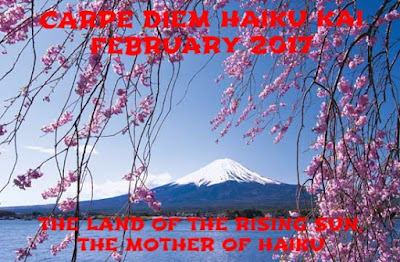!! Our prompt-list for March is complete, you can find it in the menu above !!
Dear Haijin, visitors and travelers,
Welcome at the penultimate episode of CDHK February 2017. This month we were "in a way" on a journey through Japan, the Mother land of Haiku. We have visited this wonderful country and we discovered the beauty of Japanese Art. Earlier this month we had an episode about the samurai and I just felt the need to bring also an episode about the geisha.
Recently I saw "Memories of a Geisha" for the third time I think. It's an awesome movie in which we can see the geisha culture of ancient Japan. I loved that movie, not only for its story, but also for the wonderful scenes of Japan.
 |
| Scene from "Memoires of a Geisha" |
Geisha, like all Japanese nouns, has no distinct singular or plural variants. The word consists of two kanji, 芸 (gei) meaning "art" and 者 (sha) meaning "person" or "doer". The most literal translation of geisha into English would be "artist", "performing artist", or "artisan."
Apprentice geisha are called maiko (literally "dance child") or hangyoku "half-jewel" (meaning that they were paid half of the wage of a full geisha), or by the more generic term o-shaku, literally "one who pours (alcohol)". The white make-up and elaborate kimono and hair of a maiko is the popular image held of geisha. A woman entering the geisha community does not have to begin as a maiko, having the opportunity to begin her career as a full geisha. Either way, however, usually a year's training is involved before debuting either as a maiko or as a geisha. A woman above 21 is considered too old to be a maiko and becomes a full geisha upon her initiation into the geisha community.
As I was preparing this episode I ran into an article about male geisha or Taikomochi I wasn't aware of the fact that there would be male geisha too, so I was intrigued by that, so I love to tell you also a little bit about the Taikomochi. (Source: Taikomochi, the male geisha)
 |
| Taikomochi Arai, the only taikomochi living today |
The taikomochi, or the houkan, were the original male geisha of Japan. The Japanese version of the jester, these men were once attendants to daimyo (feudal lords) from the 1200s, originating from the 'Ji Sect of Pure Land Buddhism' sect which focused on dancing. These men both advised and entertained their lord and came to be known as doboshu ('comrades'), who were also tea ceremony connoisseurs and artists. By the 1500s, they became known as otogishu or hanashishu (storytellers), where they focused on story telling, humor, conversation. They were sounding boards for military strategies and they battled at the side of their lord.
A time of peace began in the 1600s and the otogishu and hanashishu no longer were required by their lords, and so they had to take on a new role. They changed from being advisors to becoming pure entertainers, and a number of them found employment with the yujo, high class Japanese courtesans.
Awesome ... I really didn't know about the existence of Taikomochi, the male counterpart of the Geisha.
Ah! the beauty of nature -
geisha, peonies in her hair,
playing the Shakuhachi
© Chèvrefeuille
And I found another haiku about geisha in my archives. This one can be seen as a haiku with a hidden meaning according to what I wrote above about the male geisha, the Taikomochi, but than you have to think back about the more erotical meaning of morning glory.
morning glories -
geisha in her silken kimono
rustles along them
© Chèvrefeuille
Well ... with this "double thought"-haiku I love to conclude this episode. This episode is open for your submissions tonight at 7.00 PM (CET) and will remain open until March 3rd at noon (CET). I will try to publish our last episode of February later on.

Oh, my, those geisha and their rustling! Wonderful!
ReplyDelete